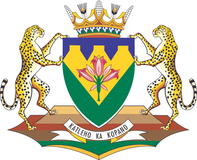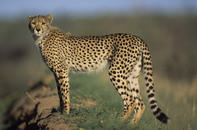The Free State Coat of Arms was officially granted on May 7th 1999. It has a multicoloured base of green, browns and beiges portraying the earth of the Free State.

The motto KATLEHO KA KOPANO - written in Sesotho means prosperity through unity. The shield is coloured green, yellow and blue. The green represents the grasslands, the blue the sky and the yellow the sandstone formations of the Eastern Free State.
In the centre of the yellow shape is the indigenous Orange River Lily. On top of the shield is a crown set with diamonds and corn cobs representing the rich agricultural lands and mining heritage of the Free State. The supports are two cheetahs.
Animal Symbol - Cheetah (Acinonyx jubatus)

With a greyhound shaped body, long legs, large heart and lungs and wide nasal passages, a cheetah is built for speed. In fact, it is the fastest land animal on the planet. The cheetah is part of the cat family, although it looks more dog-like, and doesn’t have retractable claws, like all the other cats. Keeping the claws out helps with maintaining speed when charging.
The cheetahs long tail is used as a rudder and stabilizer when running at full tilt after its prey. A cheetahs acceleration is a sight to see, from crouching to full speed in less than 60 m with speeds clocked up to 114 km\h. Their prey, which is anything from a scrub hare to small antelope will try to desperately evade the charging cheetah by weaving and dodging between bushes and trees. It is usually a race of speed, cunning and stamina the loser being either eaten or hungry.
Cheetahs are probably a more successful hunter than any other big cat, when taking its prey by surprise. However, as they are much lighter than the other big cats they often forfeit their meal to lions and leopards, especially as they first need to catch their breath before they can begin to feed. Cheetahs have home ranges rather than territories, which they mark with urine, but don’t actively defend by fighting. Coalitions of cheetah brothers are common.
Flower Symbol - Orange River Lily (Crinum bulbispermum)
The Orange River lily is a large bulbous plant that can grow up to 1m tall. It has grey-green leaves, a tall stem and hanging lily type flowers, which are pink with a red stripe in each petal. As the name suggests, these flowers grow along stream banks and in swampy grasslands. The flowers have a sweet but sickly scent that attracts insects for pollination.
Orange River lilies bloom during the summer months. Once the flowers fall, fruit is produced in a large pink capsule which contains the seeds. The seeds are bulbous and germinate as soon as they reach the ground. The bulbs are protected by layers of papery bulb scales, which acts as a form of protection during the dry winter months. The Orange River lily is used in traditional medicine to help relieve rheumatism, varicose veins and the reduction of swelling. It is also believed, by some, to protect homes from evil.